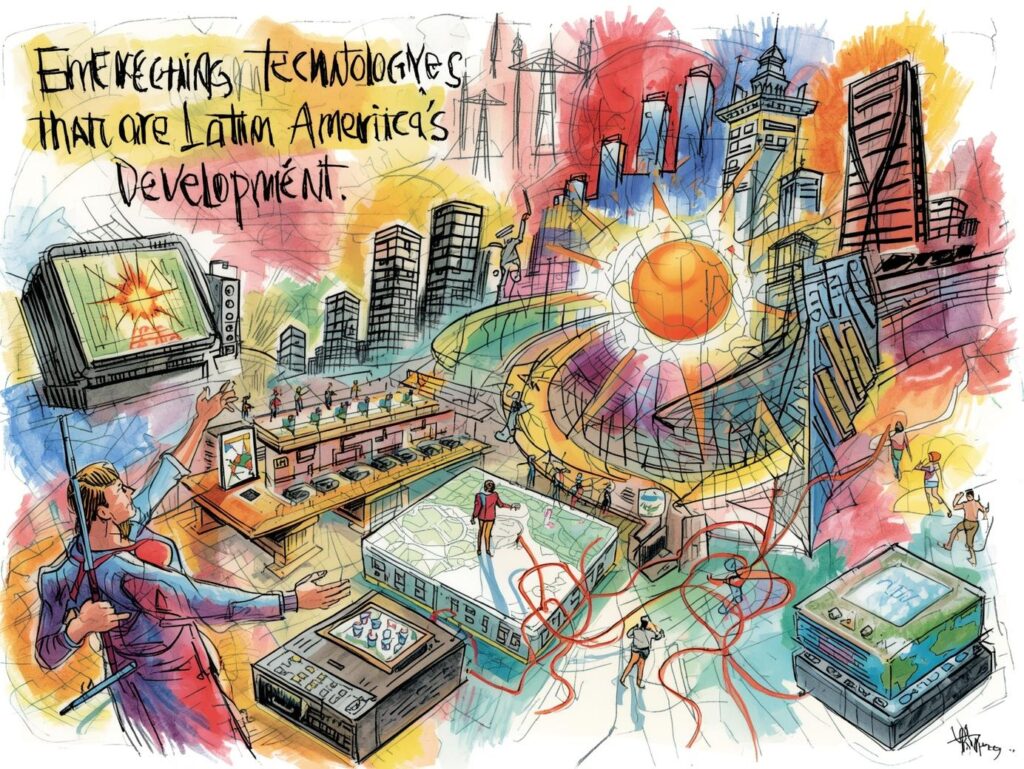Introduction
Latin America is experiencing a technological transformation that promises to reshape economic, social, and environmental landscapes. Emerging technologies—such as Artificial Intelligence (AI), blockchain, the Internet of Things (IoT), digital health tools, and renewable energy solutions—are driving innovation across sectors, offering solutions to longstanding development challenges.
At CHUYA SONCCO, we see these technologies not only as tools for progress but as strategic enablers to foster equitable, sustainable, and inclusive development throughout the region.

Key Emerging Technologies
1. Artificial Intelligence (AI)
- AI enables data-driven decision-making in agriculture, health, education, and public policy.
- Predictive analytics, machine learning, and AI-assisted diagnostics improve efficiency and outcomes.
- Example: Using AI to forecast disease outbreaks or optimize crop production.
2. Blockchain
- Blockchain ensures transparency, accountability, and security in finance, supply chains, and public services.
- It enhances trust and inclusivity, particularly for marginalized populations.
- Example: Blockchain-based platforms for fair trade and microfinance.
3. Internet of Things (IoT) and Smart Infrastructure
- IoT devices monitor environmental conditions, urban traffic, and public utilities.
- Smart cities and communities can optimize resource use, reduce waste, and improve living standards.
- Example: Sensor networks for water management in urban and rural areas.
4. Digital Health Technologies
- Telemedicine, wearable devices, and AI-powered health monitoring expand access to healthcare.
- Enables remote diagnostics, preventive care, and personalized treatment, especially in underserved regions.
5. Renewable Energy and Green Tech
- Solar, wind, and bioenergy solutions reduce reliance on fossil fuels.
- Smart grids and energy management systems improve efficiency and sustainability.
- Example: Microgrid solar systems powering rural communities.

Impact on Development
1. Economic Growth and Entrepreneurship
- Emerging technologies foster startups, innovation hubs, and digital entrepreneurship.
- They create jobs in tech, research, and service sectors, stimulating local economies.
2. Social Inclusion
- Digital platforms, e-learning, and mobile technologies bridge gaps in education, healthcare, and finance.
- Vulnerable populations gain access to services and opportunities previously out of reach.
3. Environmental Sustainability
- Smart agriculture, energy monitoring, and IoT-enabled conservation help communities adapt to climate change and manage resources responsibly.
4. Governance and Transparency
- Technologies like blockchain improve accountability in public spending and civic engagement.
- Citizens can participate actively in decision-making and monitoring public projects.
Challenges and Considerations
1. Digital Divide
- Unequal access to internet, devices, and digital literacy limits technology’s reach.
2. Regulatory and Policy Gaps
- Emerging technologies often outpace legislation; governments must develop clear frameworks.
3. Skills and Education
- Preparing the workforce requires STEM education, digital skills, and lifelong learning programs.
4. Ethical and Social Responsibility
- Technology must respect privacy, human rights, and ethical standards.
5. Sustainability and Resource Management
- Technologies must be environmentally responsible and scalable to benefit local communities.

The Role of CHUYA SONCCO
CHUYA SONCCO leverages emerging technologies to foster inclusive development in Latin America through:
- AI and Digital Transformation Projects
- Enhancing public health, education, and community services with predictive analytics and AI tools.
- Blockchain and Financial Inclusion
- Supporting transparent financial systems, microfinance, and fair trade initiatives.
- Digital Health Programs
- Expanding telemedicine, wearable devices, and AI-powered diagnostics in underserved regions.
- Sustainability and Green Technology Projects
- Implementing smart agriculture, renewable energy, and environmental monitoring initiatives.
- Education and Capacity Building
- Training youth, women, and marginalized communities in digital skills, STEM, and technology literacy.
Conclusion
Emerging technologies hold transformative potential for Latin America. When applied responsibly, they can accelerate economic growth, promote social inclusion, enhance governance, and safeguard the environment.
Through innovation, education, and ethical implementation, CHUYA SONCCO envisions a region where technology empowers communities, strengthens institutions, and contributes to a sustainable and inclusive future.





